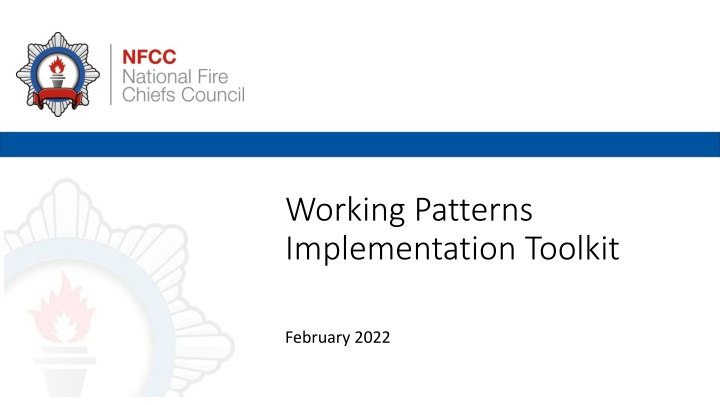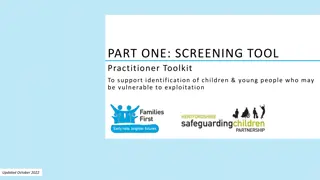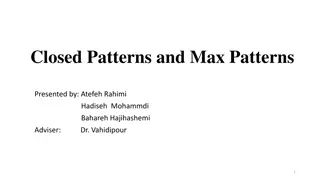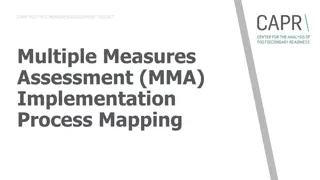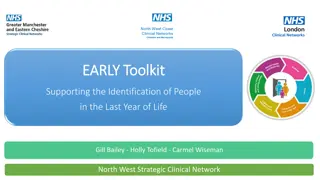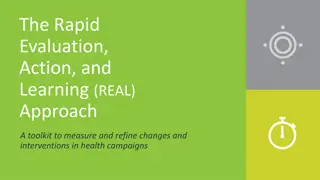Working Patterns Implementation Toolkit: Insights and Case Studies
Explore the Working Patterns Implementation Toolkit for February 2022, which includes case studies based on research involving UKFRS to document working patterns. Discover detailed information on services, international comparisons, firefighter and fire station statistics, dual contracts, and wholetime staffing patterns.
Download Presentation

Please find below an Image/Link to download the presentation.
The content on the website is provided AS IS for your information and personal use only. It may not be sold, licensed, or shared on other websites without obtaining consent from the author.If you encounter any issues during the download, it is possible that the publisher has removed the file from their server.
You are allowed to download the files provided on this website for personal or commercial use, subject to the condition that they are used lawfully. All files are the property of their respective owners.
The content on the website is provided AS IS for your information and personal use only. It may not be sold, licensed, or shared on other websites without obtaining consent from the author.
E N D
Presentation Transcript
Working Patterns Implementation Toolkit February 2022
Working Patterns Case Studies Based on a project involving all UKFRS to research and record working patterns Resulted in the delivery of working pattern case studies, details about provision across all services and international comparators 50 Services have provided a SPOC (inc all British Isles) 44 provided policy documentation including duty systems and collective agreements 9 case studies have been written 1 Case Study Implementation Tool
Firefighter totals WT OC Totals 35,291 6,573 3206 1,729 46,799 WT 65% 55% 45% 48% 61% OC 35% 45% 55% 52% 39% 2020 2019 2019/20 2020 England Scotland Wales NI UK 22,793 3,636 1,453 822 28,704 12,498 2,937 1,753 907 18,095 Figures from Devolved Administrations and Home Office Headcount figures, not FTE Requested wholetime/on-call from SPOCs
Fire Station totals WT 425 50 32 OC 734 283 108 46 1171 Mixed 236 WT 30% 14% 21% 10% 26% OC 53% 79% 72% 68% 59% Mixed 17% 2020 2019 2018/19 Wales 2020 England Scotland 23 9 7 275 6% 6% 10% 14% NI UK 7 514 Figures from Devolved Administrations and Home Office Mixed stations are combined WT/OC or DC/OC
Working Patterns data Dual contracts (wholetime / on-call staff) Dual contract staff as % of sample workforce Dual contract staff as % of wholetime Dual contract staff as % of on-call % 6 11 13 Met. services: LFB, GMFRS and WMFS removed from sample Based on responses from 44 Service SPOCs with 28 providing data Home Office and Devolved Administrations figures for underlying headcount figures Dual contracts of 28 services providing data Dual contract staff as % of sample workforce Dual contract staff as % of wholetime Dual contract staff as % of on-call % 10 23 17 Service policies indicate 36 services with dual contract staff Second table breaks down dual contracting for the 28 services, which provided data
Wholetime totals Wholetime Working Patterns Total Wholetime Sample Total Services with a Wholetime 2-2-4 pattern Total Services with Wholetime/On-call staff(Dual Contracts) Total Services with joint crewing (WT/OC on one watch)* 48 43 36 11 * For example, on-call staff providing overtime, resilience cover on wholetime watches to cover wholetime staff shortages
Variation on 2-2-4 Patterns 2-2-4 day hours 09:00 -18:00 07:00 -19:00 08:00 -18:00 08:00 -19:00 08:00 -20:00 07:00 -18:00 07:30 -18:00 07:30 -18:30 07:30 -19:30 08:00 -17:00 08:00 -18:00 (m-f), 08:00-16:00 (w/e) 08:15 -18:15 08:30 -18:30 08:30 -19:00 08:30 -20:30 09:00 -19:30 09:30 -20:00 Grand Total Sub total 15 4 4 4 2 1 1 1 1 1 1 1 1 1 1 1 1 41
Variation on 120 hour on-call contracts 120 variations <120 or >120 120-90 <120-120-100-80-40-50 100-85-70 105 94.5-84-73.5-63-52.5-42-31.5 110-100-90-80-70-60-50 120-xx-36 120-100-80 120-108-96-90-84-72-60-48 120-70-35 120-80-40 120-84 120-90- <90 120-90-64 120-90-74 120-sliding scale-40 120-xx-30 120-xx-50 xx-84-50-30 42 Unknown Grand Total Sub total 4 4 1 1 1 1 1 1 1 1 1 1 1 1 1 1 1 1 1 1 1 27
Variation on Day Crewing Patterns Day Patterns per service Unknown / tbc 1 2 3 Grand total Sub total 4 17 10 1 31 31 of the services have one or more stations on a day crewing pattern 10 Services have more that one day crewing patterns across the establishments 1 service has 3 different patterns
Variation on Day Crewing Patterns Day Patterns per service Total day crewing and OC evenings Total day crewing including weekends Total day crewing 4 on 4 off 2 watch system Total weekday plus / self rostered patterns Total day crewing 2 on, 2 off, 3 on, 2 off, 3 on two week rota Total 9 day fortnight (4d on 3 off, 5 on 2 off etc) Total 24 hour rotations (PH and standby) Total day crewing 3 on 3 off 2 watches Total day crewing 4 days then 5th day every 4 weeks Total 7 day fortnight Sub total 23 16 10 9 6 6 4 4 3 1 Some services use several of these patterns refined for specific stations depending on local need Some services have wholetime staff working weekends at some stations but weekly crewing at others
Variation on Day Crewing Patterns Core Hours (inc PH and FH) 08:00-20:00 08:00-17:00 07:00-19:00 08:00-18:00 08:00-19:00 07:00-19:00(3/3) / 09:00-21:00w,10:00-17:00we(4/4) 07:30-19:30 / 07:00-19:00 07:00-19:00 / 08:00-18:30 t-f 07:00-18:00 08:00-18:30 07:30-18:30 08:00-18:00 / 08:00-20:00 07:00-19:00 / 08:00-20:00 06:00-18:00 08:30-18:00 / 07:30-18:00 09:00-17:00 08:30-20:30 08:30-18:30 08:00-17:20 / 07:00-19:00 Grand Total Sub total 4 3 3 3 2 1 1 1 1 1 1 1 1 1 1 1 1 1 1 29 These working patterns include some services including a period of positive hours or flex-time Some services have a range of patterns depending on local needs Some services include different hours on different days of the week Services with multiple patterns grouped together
Innovative Working Patterns 9 Case Studies Innovation Description Example Services 1. Ridership Impact on adjusting establishment levels on staffing and costs Kent, Cumbria 2. Remote Resource and Virtual Crews Watches deployed from HQ or a virtual station to meet gaps across establishments West Yorks, South Yorks, West Sussex, Oxford 3. Optimum on-call contracts Moving from traditional 120 to be more demand led Humberside, H&W 4. Dual Station Crews or managers who straddle more that one station depending on time of day Cumbria, Essex 5. Pay for Availability Alternative incentives Devon and Somerset 6. Day Crewing + Explanation of pros and cons of this model 7. Variations on 2-2-4 Alternatives and changes such as increased rota days Scotland, West Sussex 8. Delayed Turnout Second pumps not rolling as first response vehicles Merseyside 9. Flexible Mobilising Various smaller innovations Surrey, Gloucestershire, Lincs
Working Pattern Implementation Tool
Working Pattern Implementation Tool Developed to accompany case studies Designed in consultation: Working Patterns Project Board On-Call Practitioners Group Service Single Points of Contact (Working Patterns SPOCS) NFCC People Engagement Forum Individual Services testing with project teams and staff
Working Pattern Implementation Tool Used to measure existing working patterns or a new pattern to provide measurable and transparent comparative indicators The toolkit could: 1. Support a service to measure completely new ideas for a working pattern against an existing set of criteria, developed by the NFCC Working Patterns Project or 2. Support services to measure existing working patterns in operation in one or more service and see how these patterns may relate to their staff, communities and organisation.
Working Pattern Implementation Tool The tool has six pillars to compare one working pattern with another: 1. Competency 2. Efficiency and Effectiveness 3. Equality, Diversity and Inclusion 4. Safety 5. Well-being 6. Community Impact There is a scoring mechanism to provide a means to weigh the comparative scores of each pillar against the others. There are 16 measurable criteria cross referenced to relevant pillars
Working Pattern Implementation Tool Measurable criteria: 1. Availability of the appliance can be maintained within IRMP requirements and community need 2. Combined training between duty systems, locations, drill nights is accommodated 3. Control of the working pattern over and above legal requirement 4. Data drives staffing requirements to adjust crew availability based on skills and community risk profiles 5. Facilitates positive working environment through movement of staff between watches and duty systems 6. Individual staff are not pressurised to maintain availability levels 7. Scheduling accounts for commuting challenges when staff are rostered to different locations per shift 8. Staff have control of their hours and availability to fit around personal commitments and work life balance 9. Staff have time to pursue CPD and training opportunities 10. Staff in multiple roles have adequate rest 11. The prevent and protect needs of the community are met by maintaining adequate staffing 12. The working pattern accommodates and engages with a safety first culture 13. The working pattern is resilient to changing political and staffing factors 14. There are adequate rest periods for staff 15. There are opportunities to support work outside of the role map 16. There is opportunity for ongoing engagement with local communities
Working PatternImplementation Tool Using the tool 1. Put the name of the working pattern here 2. Discuss each pillar in turn and consider whether the working pattern under discussion achieves the criteria Y or N, specifically for that pillar. In this example, does the working pattern meet a Competency requirement to support combined training between duty systems, locations and drill nights?
Working Pattern Implementation Tool Using the tool 3. Each Y adds 1 to the score, each N subtracts 1 4. You may want to write notes to accompany your analysis
Working Pattern Implementation Tool Using the tool 5. When the analysis is complete you will have an evaluation score to use for comparisons between working patterns and pillars providing quantitative and qualitative measures
